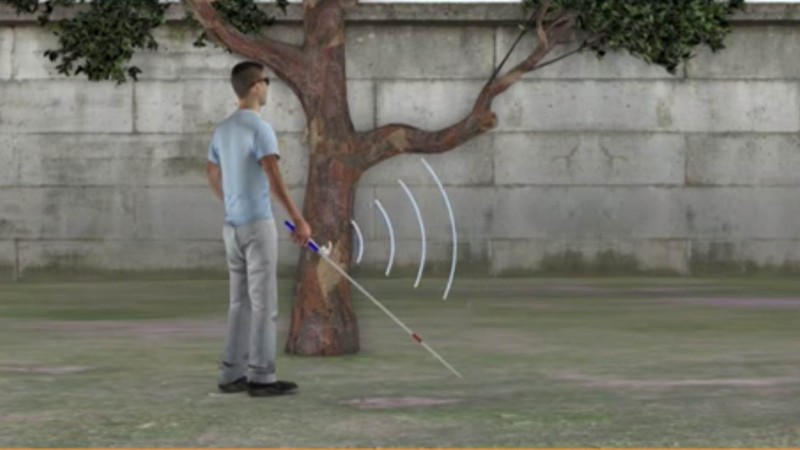 |
| Screenshot from the video explaining how SmartCane works |
One out of every three blind people in the world (an estimated 15 million) lives in India. There are approximately 2 million blind children in India and only 5 percent of them receive any education.
Visually impaired people face no shortage of problems in India, where disabilities can be especially challenging. Pedestrians are often forced onto the street, as sidewalks are cluttered with vendors, animals, and other obstacles. Blind people typically use canes, of course, but the traditional cane cannot detect objects higher than one's waist. Inventing an affordable and simple tool to aid the visually impaired has been a priority for many researchers across the world. Innovations like Roshni, also developed by students at IIT Delhi, are promising, but suffer from various logistical issues that make large-scale production impractical.
Professor Meenakshi Balakrishnan, a computer engineer at the Indian Institute of Technology in Delhi, lead a team of researchers and students to develop SmartCane, which emits ultrasound waves to detect nearby obstacles and vibrates to warn the user. It was officially launched last March. SmartCane copies the skills of animals, like bats, which also emit sonar calls into their surroundings and guide themselves using echoes. The vibration is much better than an audio alert, moreover, because sound may not be audible on noisy streets.
Brilliant lowcost "SmartCane" for visual #disabled comes out of @iitdelhi Great to see social #innovation like this. http://t.co/ccU794YXoH
— swaraj barooah (@swarajbarooah) July 22, 2014
Unlike a similar British innovation, the $985-USD UltraCane, the SmartCane is affordable at just INR 3000 (about $50).The video below depicts a typical day in the life of a SmartCane user, portraying the various challenges one faces:
The field stage validation trial of Smartcane was conducted among approximately 150 users in 6 cities in India of which almost all are now regular SmartCane users. The training/learning material for SMartCane is available for download in Hindi and English in different formats like epub, daisy, braille, clear print, etc.
According to the Facebook page of SmartCane, the device is being provided to the under privileged visually impaired in Punjab for INR 400 only under the Partial Subsidy Scheme aided by the National Donation Pool.
Right now the SmartCane is available to the user from a network of over 16 welfare organizations for the blind across 12 states in India. Here is a video of a SmartCane use of a College girl:
The Better India magazine lists some user comments:
“It is a very useful device because earlier with a regular cane, I quite often collided with vehicles like truck, tractor or bus. This was because my cane would pass beneath these big vehicles and I would collide abruptly. I have got injuries on my forehead due to such incidents. With this device I get a pre-warning of such dangerous obstacles through vibrations. This also helps me in detecting street animals such as a cow.” - Ketan from AhmedabadRecently, celebrities like Bollywood Actress Vidya Balan have come forward to publicise the SmartCane.
“It feels great to be able to move around alone. I no more take help from people to move around. I now enjoy being all by myself. Family and friends now have the confidence in me that I can travel independently without getting hurt or injured.” - Indrani from Mumbai
#VidyaBalan @ Distribution & Awareness Function Of Smartcane ! http://t.co/3AlBhNJ7Hj
— BollywoodUncut (@BollywoodUncut) August 6, 2014
As the SmartCane's publicity grows, so too will its user base hopefully expand, putting this ingenious new device in the hands of more and more people. The post was first published in Global Voices Online
























0 comments:
Post a Comment